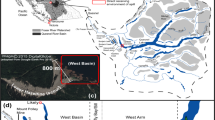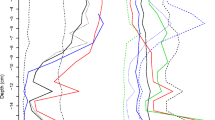Abstract
The detection of the freshwater genus Rhizosolenia (Bacillariophyceae) remains in sediments is affected by the oxidants used in the digestion procedures. The Rhizosolenia counts decrease from 30% H2O2>50% HNO3>50% chromic acid>100% HNO3>100% H2SO4. Rhizosolenia is mostly found in Ontario lakes with summer average pH ranging from 5.6 to 8.3, Gran alkalinity from 0.2 to 120 mg L−1 as CaCO3 and water colour from 4 to 105 Hazen units. Large Rhizosolenia populations are generally found in clear lakes, neutral pH and low alkalinity.
Similar content being viewed by others
References
AsmundB., 1955. Five Danish lakes and their population of Rhizosolenia longiseta. Dansk Bot. Arkiv. 15(5): 1–68.
BattarbeeR. W., 1973. A new method for the estimation of absolute microfossil numbers, with special reference to diatoms. Limnol. Oceanogr. 18: 647–653.
BattarbeeR. W., 1984. Diatom analysis and the acidification of lakes. Phil. Trans. R. Soc. Ser. B. 305: 451–477.
Bleiwas, A. S. H., 1983. Plankton communities and zooplankton grazing rates in some acidic and circumneutral Ontario lakes. M.Sc. Thesis, Univ. of Toronto: 211 pp. & appendices 1–4.
CharlesD. F., 1985. Relationship between surface sediment diatom assemblages and lakewater characteristics in Adirondack lakes. Ecology 66: 994–1011.
CharlesD. F. & S. A.Norton, 1986. Paleolimnological evidence for trends in atmospheric deposition of acids and heavy metals. In Atmospheric Deposition: Historical Trends and Spatial Patterns, Ch. 9. National Academy Press, Washington, D.C.
DavisR. B. & J. P.Smol, 1986. The use of sedimentary remains of siliceous algae for inferring past chemistry of lake water — problems, potential and research needs. In SmolJ. P., R. W.Battarbee, R. B.Davis & J.Meriläinen (eds.), Diatoms and Lake Acidity. W. Junk Publishers, Dordrecht, p. 291–300.
DavisR. B. & D. S.Anderson, 1985. Methods of pH calibration of sedimentary diatom remains for reconstructing history of pH in lakes. Hydrobiologia 120: 69–87.
DavisR. B., D. S.Anderson & F.Berge, 1985. Paleolimnological evidence that lake acidification is accompanied by loss of organic matter. Nature 316: 436–438.
Davis, R. B. & F. Berge, 1980. Atmospheric deposition in Norway during the last 300 years as recorded in SNSF lake sediments, II. Diatom stratigraphy and inferred pH. In D. Drabløs & A. Tollan (eds.), Ecological Impact of Acid Precipitation. Proc., Int. Conf. Ecol. Impact Acid Precip., SNSF Project, Oslo, Norway: 270–271.
DeNicolaD., 1986. The representation of living diatom communities in deep-water sedimentary diatom assemblages in two Maine (USA) lakes. In SmolJ. P., R. W.Battarbee, R. B.Davis & J.Meriläinen (eds.), Diatoms and Lake Acidity. W. Junk Publishers, Dordrecht, p. 73–85.
DenisegerJ., A.Austin, M.Roch & M. J. R.Clark, 1986. A persistent bloom of the diatom Rhizosolenia eriensis (Smith) and other changes associated with decreases in heavy metal contamination in an oligotrophic lake, Vancouver Island. Environ. Exp. Bot. 26: 217–226.
DickmanM., S.Dixit, J.Fortescue, R.Barlow & J.Terasmae, 1983. Diatoms as indicators of the rate of lake acidification. Wat., Air, Soil Pollut. 21: 227–241.
Huber-Pestalozzi, 1942. Das Phytoplankton des Susswassers. Diatomeen. In A. Thienemann (ed.), Die Binnegewasser, Stuttgart. Band XVI(2): 367–549.
HurlbertS. H., 1984. Pseudoreplication and the design of ecological field experiments. Ecological Monographs 54: 187–211.
KerfootW. C., 1977. Implications of copepod predation. Limnol. Oceanogr. 22: 316–325.
Kling, H. J. & S. K. Holmgren, 1972. Species composition and seasonal distribution in the experimental lakes area, northwestern Ontario. Fish. Res. Bd. Canada, Tech. Rep. No. 337, 56 pp.
LoweR. L., 1974. Environmental requirements and pollution tolerance of freshwater diatoms. EPA-670/4–74/005. U.S. Environmental Protection Agency, Cincinnati, Ohio: 333 pp.
LundJ. W. G., C.Kipling & E. D.LeCren, 1958. The inverted microscope method of estimating algal numbers and the statistical basis of estimations by counting. Hydrobiologia 11: 143–170.
MeriläinenJ., 1967. The diatom flora and the hydrogen-ion concentration of water. Ann. Bot. Fenn. 4: 51–58.
Mayhew, E. A., E. R. Bernabe & J. B. Festin, 1974. Morphological differentiation, counting technique comparisons and seasonal variation in two species of Rhizosolenia from Lake Michigan. 17th Conf. Great Lakes Res. Unpublished Ms.
Nicholls, K. H., 1976. Comparitive limnology of Harp and Jerry Lakes—adjacent cottaged and uncottaged lakes on southern Ontario's Precambrian Shield. Ontario Ministry of the Environment Report, Toronto, Ontario, 87 p.
NichollsK. H., E. C.Carney & G. W.Robinson, 1977. Phytoplankton of an inshore area of Georgian Bay, Lake Huron, prior to reduction in phosphorus loading. J. Great Lakes Res., Internat. Assoc. Great Lakes Res. 3: 79–92.
Ontario Ministry of the Environment, 1981. Outline of analytical methods. Ontario Ministry of the Environment Laboratory Services Branch, Toronto, Ontario.
OstrofskyM. L. & H. C.Duthie, 1975. Primary productivity, phytoplankton and limiting nutrient factors in Labrador lakes. Int. Revue ges. Hydrobiol. 60: 145–158.
PorterK. G., 1977. The plant-animal interface in freshwater ecosystems. Am. Sci. 65: 159–170.
RoundF. E., 1964. The diatom sequence in lake deposits: some problems of interpretation. Verh. Int. Ver. Limnol. 14: 1012–1020.
SmithH. L., 1882. Rhizosolenia gracilis, n. sp. Trans. Am. Micr. Soc. 4: 177–178.
SmithH. L., 1878. Description of new species of diatom. Amer. Quart. Microsc. Jour. 1: 12–18.
StockerJ. G., 1971. Preliminary characterization of lakes in the experimental lakes area, northwestern Ontario, using diatom occurrences in sediments. J. Fish. Res. Bd. Canada. 28: 265–275.
Stokes, P. M. & Y.-K. Yung, 1985. Final report on the distribution of phytoplankton in 46 northern New England lakes. Environment Canada contract # OISE. KW405-5-0549.
Author information
Authors and Affiliations
Rights and permissions
About this article
Cite this article
Yung, Y.K., Nicholls, K.H. & Cheng, A.G. The detection of Rhizosolenia (Bacillariophyceae) in sediment of Ontario lakes and implications for paleoecology. J Paleolimnol 1, 61–69 (1988). https://doi.org/10.1007/BF00202194
Issue Date:
DOI: https://doi.org/10.1007/BF00202194




